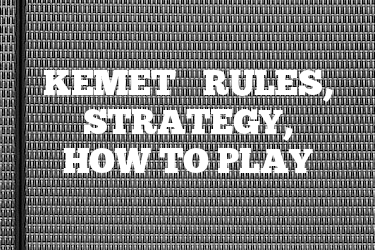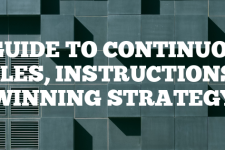Kemet: A Guide to Victory – Rules, Strategy Guide & Tips
Introduction
Kemet, a game that’s all about ancient Egyptian warfare with a mystical twist. It’s a strategy board game where you play as a god from Egyptian mythology, trying to earn the most points to win. The game is known for its aggressive style and the fact that you can’t just sit back and defend. You’ve got to be proactive and attack to get ahead.

Kemet was released in 2012 and has been a hit in the board game community for its deep strategy and unique theme. The game stands out for me because it mixes mythical creatures, like giant scorpions and mummies, with historical elements from ancient Egypt. That combo just tickles my inner history nerd. It’s a game that’s easy to learn but hard to master, and it’s got a lot of replay value because of all the different strategies you can try.
Quick Tip for Kemet
Always keep an eye on your opponents’ moves and be ready to adapt your strategy on the fly. Flexibility is key!
Rules for playing Kemet
Let’s dive into the rules of Kemet. The game is played over a series of turns where players collect prayer points, buy power tiles, summon creatures, and move their troops to control temples and other strategic locations on the board. The goal is to earn victory points, and the first player to reach a set number of points triggers the end of the game.
Each player has an individual player board that tracks their actions, power tiles, and creatures. You start with a set number of units and three action tokens. On your turn, you can use these tokens to perform actions like moving units, upgrading your pyramid, praying for more points, or buying power tiles that give you special abilities.
Combat is simple but strategic. When you fight another player, you both secretly choose one of six battle cards, then reveal them at the same time. These cards add to your units’ strength and can have special effects. The winner gets a permanent victory point, and the loser has to retreat.
There are three types of power tiles in Kemet: red for attack, blue for defense, and white for economy and maneuverability. Choosing the right combination of tiles is crucial for your strategy.
Equipment and Setup for Kemet
To play Kemet, you need the game board, which shows the map of ancient Egypt, divided into regions with temples and other key locations. Each player gets a set of units, a player board, action tokens, and an initial set of prayer points. You also need the power tiles, battle cards, and creature figures.
Setting up the game involves placing your pyramids on the board, which determine what power tiles you can buy. You also place your units in your city and get ready to start conquering.
If you don’t have the game, you could try making a DIY version, but it’s a lot of work because there are so many unique pieces. The tiles in Kemet are especially important because they give you your special abilities, so you’d need to find a way to replicate those.
How to Play Kemet and Game Mechanics
Playing Kemet involves several key mechanics:
- Prayer Points: You use these as currency to buy tiles, summon creatures, and perform actions.
- Power Tiles: These give you new abilities and can be bought by upgrading your pyramids.
- Combat: When you fight, you use battle cards to add to your strength and try to outwit your opponent.
- Victory Points: You earn these by winning battles, controlling temples, and having certain power tiles.
The game is played in turns, with each turn having five phases:
- Night Phase: Players get prayer points.
- Dawn Phase: Determine the turn order.
- Day Phase: Players take actions using their action tokens.
- Dusk Phase: Temples give victory points to the players who control them.
- End of Turn: Check if anyone has reached the victory point threshold to win.
How to Win at Kemet
To win at Kemet, you need to earn victory points faster than your opponents. You can do this by winning battles, controlling temples, and having certain power tiles. It’s important to have a balanced strategy that includes attacking, defending, and upgrading your pyramids.
As a beginner, focus on learning how the different power tiles work and how to use your battle cards effectively. As you get more experienced, you can start to plan more complex strategies and try to predict what your opponents will do.
Advanced players will need to be very strategic about when to attack and when to hold back. They’ll also need to be good at managing their prayer points and choosing the right power tiles for their strategy.
Best Strategies for playing Kemet game
Some of the best strategies in Kemet involve being aggressive and controlling key points on the board. You should always be looking for opportunities to attack and earn victory points. It’s also important to have a mix of power tiles so you can adapt to different situations.
One sneaky tactic is to wait for your opponents to fight each other and then swoop in to take control of weakened areas. You can also try to predict what battle cards your opponents will use and choose yours to counter them.
Scenarios
In Kemet, you might find yourself in a strong position with lots of units and power tiles, or you might be struggling to keep up with your opponents. If you’re ahead, you need to keep the pressure on and try to close out the game before your opponents can catch up. If you’re behind, look for ways to disrupt the leaders and make a comeback.
One common scenario is getting into a battle where both players have a lot of units. In this case, it’s important to choose your battle card carefully and consider using a creature to tip the balance in your favor.
Frequently Asked Questions about playing Kemet game
Here are some common questions and answers:
Q: How long does a game of Kemet usually take?
A: It can take between 90 minutes to 2 hours, depending on the number of players and their experience level.
Q: Can you win Kemet without fighting?
A: It’s tough because combat is a big part of earning victory points, but you can focus on controlling temples and using certain power tiles to earn points in other ways.
Q: How many players can play Kemet?
A: The game is for 2 to 5 players.
Q: Is there a lot of luck involved in Kemet?
A: Not really. There’s some uncertainty in combat, but it’s mostly about strategy and making smart decisions.
Q: Can I play Kemet with my kids?
A: It depends on their age and interest in strategy games. Kemet is best for older kids and teens who like a challenge.
External Links
For more information on Kemet, check out these links:

Eve Brownlee was a gamer before gaming communities on the internet were a thing. Eve grew up playing traditional, standard deck card games like Rummy and Bezique, taking an interest in the classics Backgammon and Chess. Parlor card games like Bridge continue to keep Eve active in the community. After a long career, primarily in horticulture for USDA in Maryland, Eve now travels and writes on The Pineapple (pineapples.info) and contributes to Quora/Pinterest topics. Contact Eve via email.



